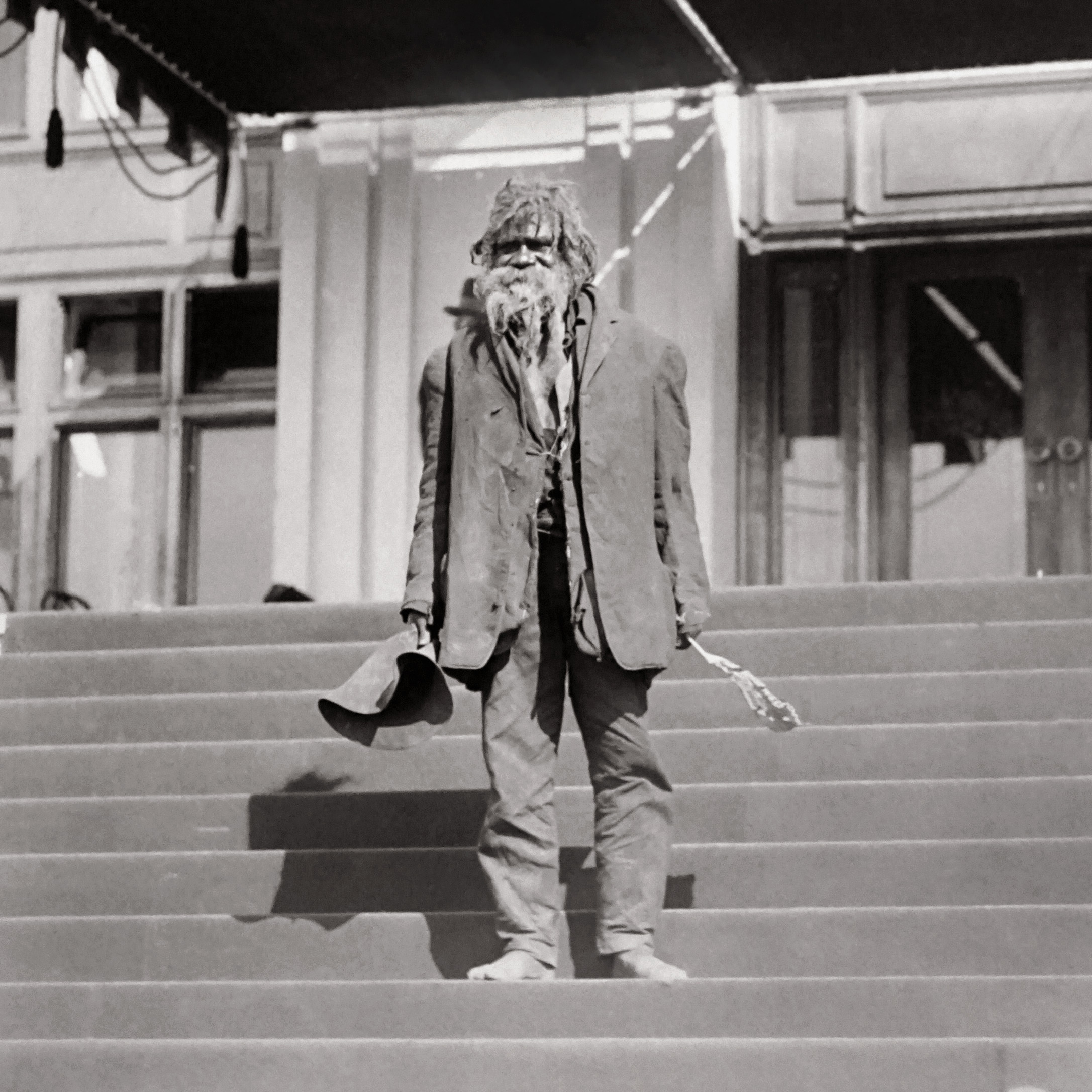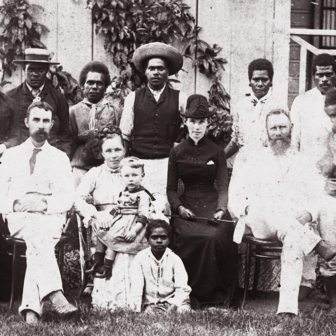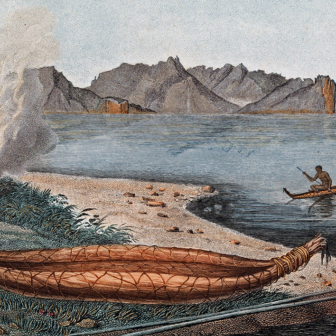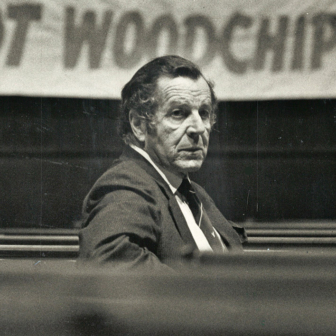On 9 May 1927, almost three decades after federation, Australia’s Commonwealth parliament finally moved from Melbourne to Canberra. Around 30,000 spectators travelled from all over the country to hear their beloved prima donna Dame Nellie Melba sing the national anthem and view the Duke and Duchess of York open (Old) Parliament House. Although no Indigenous Australians were officially invited, two Wiradjuri elders, Nangar (Jimmy Clements) and Ooloogan, (George John Noble), both around eighty years of age, walked more than 150 kilometres from Brungle Aboriginal station near Tumut in southern New South Wales to attend the opening.
The two men had come to Canberra to declaim the injustices they had endured all their lives. The following day, 10 May, prominent citizens were paraded before the Duke and Duchess as they stood atop the steps of Parliament House. Nangar was among those who passed before them. As the Argus reported, “An ancient Aborigine, who calls himself King Billy and who claims sovereign rights to the Federal Territory, walked slowly forward alone, and saluted the Duke and Duchess.” The photograph of Nangar appeared under the headline “Demanded His Rights.”
Until recently, Nangar and Ooloogan appeared in Australian history as a brief, defiant cameo in the otherwise triumphant march of Australian democracy. But in 2024, the Australian Dictionary of Biography, or ADB, published Wiradjuri historian Laurie Bamblett’s article on “Nangar (1848–1927).” Now, for the first time, we could understand Nangar’s life in its full context — Family. Nation. Country. Bamblett, a descendant of Nangar’s aunt Nellie Hamilton, explained Nangar’s cultural responsibilities as a walamira talmai — “a distinguished holder of ancient knowledge passed on by his forebears” — and his life-long role as an esteemed ambassador for his people. In the space of little more than 1200 words, Bamblett’s ADB entry finally gave Nangar’s life the dignity it deserved.
The same could be said for more than a hundred Aboriginal and Torres Strait Islander biographies recently added to the ADB. This project, which is supported by the John T. Reid Charitable Trusts, is led by Indigenous members of the ADB board and guided by a national working party of distinguished Aboriginal and Torres Strait Islander scholars who believe in the ADB and want to ensure their peoples are properly represented in the nation’s biographical dictionary.
A book of Indigenous Lives, edited by Shino Konishi, a Yawuru historian working with the ADB, will be published next year and several hundred more portraits are being commissioned. Because the subjects of these biographies are nominated by communities and many of the entries are written by Indigenous authors, there is a growing sense of Indigenous ownership of the ADB and pride in its work.
And yet the Australian National University has recently proposed drastic funding cuts that threaten this vital biographical project, and, indeed, the very survival of the ADB itself.
Since its first volume appeared in 1966, the ADB has published nearly 14,000 Australian biographies — all of them now freely available online. The ADB’s volunteers in every state and territory are constantly researching and writing new lives, with each providing a unique portal to Australia’s culture and history. As well as expanding the number of Indigenous lives represented in the dictionary, the ADB has launched projects to increase the number of women, convicts and working-class people and is advancing the urgent task of revising biographical entries written decades ago. Like Britain’s Oxford Dictionary of National Biography and the American National Biography, the ADB is an ongoing project of profound national significance.
When Australians look for engaging, thoroughly researched and trustworthy biographies of their countrymen and women from every walk of life, there is no more reliable source than the ADB. At a time when dependable, human, evidence-based information becomes more elusive by the minute, institutions like the ADB matter more than ever before. All the more reason, then, that the ANU’s recent announcement to slash three full time positions at the ADB, and “disestablish” the Australian National Dictionary, another priceless project which has tracked the changes in Australian English from colonial times to the present, represent cultural vandalism on a breathtaking scale.
The proposed cuts threaten ANU’s unique mission laid down in its founding charter of 1946. In the “Organisational Change Proposal” released this month by the dean of the College of Arts and Social Sciences, Bronwyn Parry, there is an extraordinary omission. No mention is made of the National Institutes Grant that ANU receives from the federal government for research “supporting the development of Australia’s national unity and identity, including by improving Australia’s understanding of itself and the history and culture of its Indigenous peoples, its Asia-Pacific neighbours, and its place in the international community.” ANU receives this specially targeted federal funding to support national projects such as the ADB and the Australian National Dictionary.
As former ANU chancellor Gareth Evans has argued, there is probably no finer or more enduring expression of ANU’s nation-building charter than the ADB. It has been celebrated by previous vice-chancellors as “the jewel in the crown of the ANU.” The ADB coordinates volunteer working parties in every state and territory of the Commonwealth, and from almost every university, and thus enacts a very unusual federal scholarly collaboration that only a national university can make possible.
With its relatively small budget, the ADB mobilises a vast army of eminent unpaid scholars who do this work for the public good. This is exactly what ANU was founded to do in the postwar period, and the celebrated historian Sir Keith Hancock recognised that opportunity in establishing in 1958 what has now become the largest collaborative research enterprise in the humanities and social sciences in Australia. To diminish such an achievement is an astonishing act of self-harm by ANU. The changes, if realised, will destroy the very thing that makes the university distinctive.
Professor Parry has defended the Change Proposals by stating that the ADB could easily have been cut altogether. She appears to regard the ADB as an academic unit within the gift of the dean rather than as a collaborative national institution established by the ANU council with an independent board and supported by extensive volunteer labour. She insists that the ADB is not financially self-sustaining. But such an assessment places no value on the generous gift of scholarship to ANU from Indigenous and other Australians. It deems as worthless the goodwill of “the state universities” in a highly competitive tertiary education sector. And it turns its back on the national mission and international reputation of the ANU.
ANU’s assault on the ADB and the Australian National Dictionary is taking place in the context of a sustained attack on the humanities in Australia. The Albanese government has so far failed to reverse the Morrison government’s decision to introduce a fee regime that punishes students who choose to study the humanities and social sciences. At the same time as the government has established a new national literature body, Writing Australia, to support the development of Australian literature, and inaugurated an Australian “poet laureate,” it continues to undermine younger generations’ capacity to learn the critical analytical skills that underpin a civil society.
What do we, as Australians, value? Who else will nurture and defend the languages, cultures and histories of this continent, who else will tell the life stories of this place, who else will cultivate our capacity to share a common reference point of understanding such as has been generated by the ADB? These are the potentially nation-defining questions the ANU administration has failed to ask. The stature, respect and authority of the ADB has been built up meticulously and lovingly by tens of thousands of minds over seven decades, yet it seems it can be dismissed with the wave of a hand.
We believe this is a moment that requires urgent action — not only to stop the proposed cuts to the ADB and the plan to abolish the Australian National Dictionary, but to reverse the assault on the humanities and recognise that our history and cultural life are vital to Australia’s civic intelligence and national identity. •




